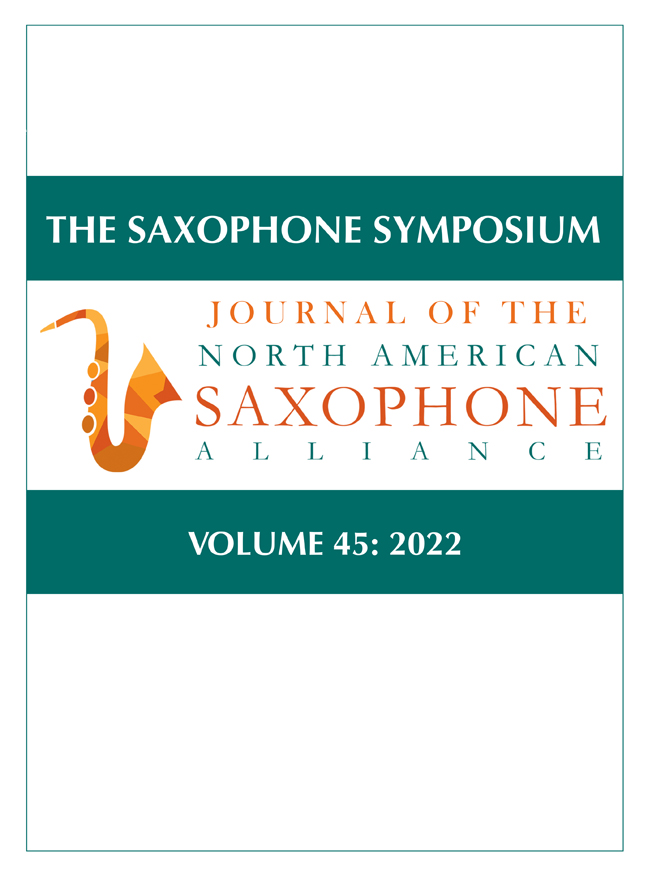Book contents
- Frontmatter
- Contents
- The Saxophone Symposium
- Nasa Executive Committee
- Notice to Contributors
- Financial Reports
- Book part
- List of Featured Concerto Performers at North American Saxophone Alliance Biennial Conferences, 1994–2020
- Asenath Mann: Boston's Gilded-Age Saxophonist
- Zechariah Goh and the Development of Classical Saxophone in Singapore
- Mrs. B. L. Hackenberger: Bessie Mecklem as Progressive-Era Clubwoman
- Elise Hall in Santa Barbara (1889–1898): The Amateur Musical Club and Philharmonic Society
- “Another American Voice” William Grant Still and the Saxophone
- The Manuscript to Jacques Ibert's Concertino da Camera: What We Can Learn from It
- Steven Bryant: In this Broad Earth
- Marco Albonetti, Amarcord d’un Tango
- Contributor Biographies
Asenath Mann: Boston's Gilded-Age Saxophonist
Published online by Cambridge University Press: 15 February 2024
- Frontmatter
- Contents
- The Saxophone Symposium
- Nasa Executive Committee
- Notice to Contributors
- Financial Reports
- Book part
- List of Featured Concerto Performers at North American Saxophone Alliance Biennial Conferences, 1994–2020
- Asenath Mann: Boston's Gilded-Age Saxophonist
- Zechariah Goh and the Development of Classical Saxophone in Singapore
- Mrs. B. L. Hackenberger: Bessie Mecklem as Progressive-Era Clubwoman
- Elise Hall in Santa Barbara (1889–1898): The Amateur Musical Club and Philharmonic Society
- “Another American Voice” William Grant Still and the Saxophone
- The Manuscript to Jacques Ibert's Concertino da Camera: What We Can Learn from It
- Steven Bryant: In this Broad Earth
- Marco Albonetti, Amarcord d’un Tango
- Contributor Biographies
Summary
Abstract
Prominent women saxophonists of the late nineteenth century had to employ creative and entrepreneurial approaches to find performance opportunities outside of the wind band, as women were not typically allowed in these ensembles. The accomplishments of Asenath Mann (1866–1951) place her among the group of pioneering saxophonists who achieved prominence during America's Gilded Age.
Mann, who was heard throughout the greater Boston area between 1882–1888, worked during the years after Etta Morgan's and Louise Linden's careers and before Bessie Mecklem’s. In contrast to these three peers, who toured extensively, Mann was able to work mostly within a 120-mile radius of her home. She appeared both as a soloist and as a member of one of the first women's orchestras in the United States. Consequently, her work patterns were not those typical of the touring “career” woman musician. Rather, they were more consistent with those of the journeyman instrumentalist, one who supplements a steady position in a band or theater orchestra with individual freelance engagements. Mann was able to perform consistently without having to tour due to the availability and variety of performing opportunities afforded by Boston's geography, demographics, and cultural institutions. Press accounts of Mann's audience reception indicate that her musical competence and artistry received greater attention than the novelty of her gender or that of her instrument, possibly her greatest accomplishment given the patriarchal society of the Gilded Age.
Keywords: Asenath Mann; Saxophonists, 19th century; women musicians; women's orchestras; Bijou Ladies Orchestra; Marion Osgood; lyceum; fraternal societies
Introduction
This article introduces American saxophonist Asenath Mann (1866–1951). Mann is significant for having been the most active of Boston's saxophonists of either gender a decade before the emergence of Elise Boyer Hall (1853–1924), a figure well known to saxophonists today. During the five and a half years she performed before the public, Mann appeared both as a soloist and as an original member of one of the first women's orchestras in the United States.
In the first four decades of the twentieth century, the saxophone was becoming increasingly visible in American popular music. The bands of John Philip Sousa, Patrick Conway, Giuseppe Creatore, Frederick Innes, and Arthur Pryor had established the instrument as an indispensable fixture. Saxophone ensembles, such as the Brown Brothers’ Sextet, flourished in vaudeville, and their more refined counterparts toured the Chautauqua and lyceum circuits.
- Type
- Chapter
- Information
- The Saxophone SymposiumJournal of the North American Saxophone Alliance, pp. 7 - 41Publisher: Boydell & BrewerFirst published in: 2024



